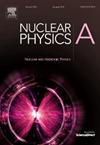Shell model study of isobaric analog states for |Tz| = 3/2 nuclei using isospin-breaking interactions
IF 1.7
4区 物理与天体物理
Q2 PHYSICS, NUCLEAR
引用次数: 0
Abstract
In mirror nuclei, the mirror energy difference in the excited states is caused by isospin-symmetry breaking. In the present work, the mechanism underlying mirror energy differences in mirror-pair is explored within the shell model formalism. For that, we performed shell-model calculations by focusing on the mirror pairs across sd-shell nuclei in the mass range A= 19-37. We used two recently developed USD-family isospin symmetry-breaking interactions, USDC and USDCm, for this purpose to explore low-lying energy spectra and mirror energy differences. The influence of single-particle states, particularly those of the s-wave, on weakly bound and unbound nuclear states was examined. Additionally, we also explored electromagnetic properties such as E2 transition probability, magnetic (μ), and quadrupole moments (Q) of those mirror pairs and compared them with the experimental data. Furthermore, we evaluated the isoscalar () and isovector () matrix elements of the E2 transition probabilities along with calculating the single proton/neutron separation energies. While the calculated results using both these interactions are in good agreement with the experimental data, the USDCm performs better for mirror energy differences.
|Tz| = 3/2核等压模拟态的壳层模型研究
在镜像核中,激发态的镜像能差是由同位旋对称破缺引起的。在本工作中,在壳模型的形式体系中探讨了镜像对中镜像能量差异的机制。为此,我们通过关注质量范围A= 19-37的sd壳层核上的Tz=±3/2镜像对进行了壳层模型计算。为此,我们使用了最近开发的两个usd家族同位旋对称破缺相互作用USDC和USDCm,以探索低空能谱和镜像能差异。研究了单粒子态,特别是s波态对弱束缚态和非束缚态的影响。此外,我们还研究了这些镜像对的E2跃迁概率、磁(μ)和四极矩(Q)等电磁特性,并与实验数据进行了比较。此外,我们评估了E2跃迁概率的等标量(M0)和等矢量(M1)矩阵元素,并计算了单质子/中子分离能。虽然这两种相互作用的计算结果与实验数据吻合较好,但USDCm对镜像能量差异的处理效果更好。
本文章由计算机程序翻译,如有差异,请以英文原文为准。
求助全文
约1分钟内获得全文
求助全文
来源期刊

Nuclear Physics A
物理-物理:核物理
CiteScore
3.60
自引率
7.10%
发文量
113
审稿时长
61 days
期刊介绍:
Nuclear Physics A focuses on the domain of nuclear and hadronic physics and includes the following subsections: Nuclear Structure and Dynamics; Intermediate and High Energy Heavy Ion Physics; Hadronic Physics; Electromagnetic and Weak Interactions; Nuclear Astrophysics. The emphasis is on original research papers. A number of carefully selected and reviewed conference proceedings are published as an integral part of the journal.
 求助内容:
求助内容: 应助结果提醒方式:
应助结果提醒方式:


